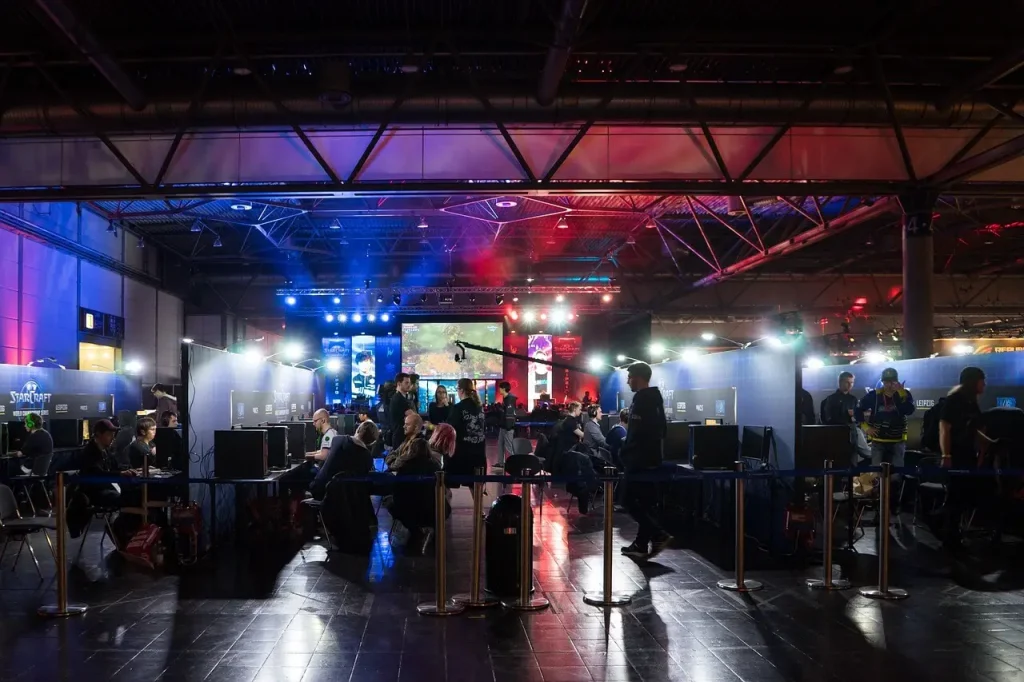Jutarnji List reports that it is no secret that esports are experiencing a strong expansion globally, as shown by fascinating figures: more than a billion dollars in revenue in 2020, more than half a billion fans, numerous eminent European clubs playing with their teams in major FIFA competitions. In pre-pandemic times, we witnessed crowded sports halls where gamers competed in front of tens of thousands of passionate fans, with hundreds of thousands of spectators via online platforms.
Confirmation that the interest in e-sports is active in Croatia was the first edition of the Hrvatski Telekom e-League, which was held last autumn. It was a competition in FIFA 21. The four biggest Croatian clubs – Dinamo, Hajduk, Osijek, and Rijeka – competed for the first time – and on the wings of exceptional results of the premiere edition, a new spring season is now beginning. Almost 900 players signed up for the first Hrvatski Telekom E-League, and records broke in terms of ratings: more than 400,000 fans watched the entire season and the charity match via YouTube and Facebook channels.
Since this is an industry that is still in its infancy in Croatia, there is currently no research or at least reliable data on the prevalence and impact of e-sports on the Croatian economy. Gordan Kožulj, senior manager in Deloitte’s business consulting department, states that globally, in 2020, e-sports exceeded one billion dollars in revenue. And Croatia?
“At the moment, there are no reliable data on the economic indicators of e-sports and its impact on the Croatian economy. We can say for sure that the impact is not significant at the moment, but it is on an upward trend and has the potential to grow faster than other segments of the economy. In fact, the entire gaming industry, of which e-sports is a part, is accelerating exponentially, and Croatia has its own bright examples of gaming companies, such as Nanobit, Croteam, Cateia, LGM, Gamepires, and others, with average annual revenue growth of as much as 50 percent. We are witnessing that some of these companies have been the target of acquisitions in the last year by major global players. This is in line with global trends in the gaming industry, where mergers and acquisitions are happening intensively. As for e-sports as a social activity in Croatia, it is also growing from year to year among the younger, predominantly male population. Moreover, e-sports is on its way to becoming a mainstream of social events. In the last two years, the number of people in the world involved in e-sports, both in watching the broadcast of various competitions and in the game itself, has increased by 25 percent, or exceeded 500 million. A survey conducted by Deloitte in 2020 on a sample of 12,000 respondents aged 16 and over revealed that more than a third of respondents from European countries had watched e-sports at least once,” explains Kožulj.
Nikola Stolnik, founder and CEO of the e-sport platform Good Game Global and a prominent member of the Croatian e-sport scene, believes not only that Croatia has a high potential for the development of e-sports but that it can be one of the backbones of the economy, which can attract many young people to come to Croatia. As a shining example, he highlights Katowice, Berlin, and Cologne, which attract hundreds of thousands of people to live events. In particular, the tournaments in Katowice, Poland, in 2018 were watched online by an audience of 40 million people, and almost 200,000 of them came to the city to watch the games live.
“We already have the infrastructure, such as Spaladium Arena, Pula Arena, Zadar sports complexes, football stadiums, all of which could be constantly used for these types of events – with a fantastic Mediterranean ambiance, because I saw with my own eyes when 35,000 people in Berlin fill the hall or stay waiting outside for e-sports events. We need to adjust the communication a bit; none of that is unattainable for us. A big advantage is that we are well connected by traffic, and we can very easily attract the whole of Central Europe,” says Stolnik.
What is the easiest way to attract them?
“Simply, with large prize funds, several hundred thousand euros per competition,” says the CEO of Good Game Global.
There are, of course, more prerequisites. Gordan Kožulj states that some basic advances have already been initiated, such as encouraging faster and better internet connection, i.e., the fifth-generation (5G) mobile network, which, he says, brings a revolutionary contribution to the development of the gaming industry and e-sports. On the other hand, he warns that teams, league organizations, and sponsors may increase fiscal scrutiny due to their increasing complexity and increasing global activities. Hence, it is possible to develop new concepts to reduce the taxation of digital business models in the gaming industry. Stolnik, on the other hand, believes that the interest of the local self-government is needed first, which should show the desire and initiative to organize such events.
Then in the second step, we would come as experts and as organizers of events and tournaments, and we would construct a project around a date that would suit them. The third important factor is sponsors, who must be international. At Good Game, we receive inquiries from e-sports sponsors every week, which has never happened before,” says Stolnik.
As the organizer of one of the largest and most influential e-sports events in the country, Hrvatski Telekom e-Liga, this company is in a unique position to have still a better insight into the current situation but also the potential of e-sports in Croatia. Richard Brešković, Marketing Director for Private Users of Hrvatski Telekom, says that, globally, the e-sports industry is becoming a significant revenue generator and has the potential for further growth in the coming years.
“Some research shows that e-sports could attract more than $1.6 billion in total revenue globally, of which $1.3 billion comes from brand investments. We are looking forward to gradually unlocking this potential through Hrvatski Telekom’s E-League, which had its premiere season in 2020. A prerequisite for the development of e-sports is a quality digital infrastructure. As far as optics are concerned, 2020 was a record year for Hrvatski Telekom, which resulted in more than 300,000 households having the fastest optical internet! There is also the first commercial 5G network in Croatia, which we launched last year, and from which the gaming community will certainly benefit greatly,” Brešković points out.
When it comes to reaping the possible fruits of such investments, Brešković warns that it is too early to talk about the return on investment, but also that “further development of the e-sports scene will lead to that.”
“Hrvatski Telekom invests significant funds in the development of optical infrastructure, as well as 5G technology, which are key prerequisites for e-sports and gaming in general. E-sport is compatible with our brand’s positioning, which we see in the extremely positive feedback from gamers after we stepped on the e-sport scene. We intend to make it more accessible throughout Croatia because we see that there is interest in it. Return on investment, of course, is significant, but it is not the only essential measure. We must not forget that in addition to being a global business, e-sports is also fun. Given the wishes and requirements of users and global market trends, it directly reflects meeting customer needs by providing an essential platform to a large, growing number of users. And that is what we do with Hrvatski Telekom e-League,” says Brešković.
The Ministry of Tourism and Sports also records an increasing number of inquiries regarding the possibility of establishing an e-sports federation, establishing e-representations, and similar initiatives.
On the wings of the first season of Hrvatski Telekom’s E-League, one of those who initiated further steps in the development of e-sports within his organization is definitely Toni Jelić, marketing director and e-sports team leader at NK Osijek. It is a club that has established its own e-sports team within the club and can testify first hand what it is like to be an entrepreneur trying to enter the e-sports arena.
“Our idea was to popularize and set the scale when it comes to e-sports in Croatia. The way we want to achieve this is quite different from the standard of setting up an e-sports team and finding players. We decided to build premises for e-sports, look for sponsors and develop possible cooperation, and thus expand the interest in e-sports in Croatia,” explains Jelić.
He adds that only a month has passed since the announcement of establishing the NK Osijek e-sport team and that it is still early to talk about concrete effects, but that the progress is visible.
“During that period, we were contacted by numerous media, people who try to be a part of that story, both sponsorship, and gaming, contacted us. Our goal is to create teams for the main e-sports titles in the next few months, in addition to the FIFA team – League of Legends, Counter-Strike: Global Offensive, and maybe even Fortnite. A slightly longer-term goal is to create competition within Croatia. When it comes to starting your own team, this process is, unfortunately, costly. It is necessary to pay the players, provide the necessary infrastructure, branding, and many other small things, such as travel expenses and the like. But that’s why it took us two and a half years, not a week. I hope that with this example, we will show people how to approach e-sports and encourage someone else to join us in the world of e-sports,” concludes Toni Jelić.
Apart from the fact that it is not easy to get involved in e-sports as an entrepreneur, it is not easy to become a professional e-sports player. The often widespread misconception that these are “children playing” cannot be further from the truth. According to the latest research, both the audience and the players are typically men aged 15 to 35 who are educated and digitally literate and have a solid budget to spend.
For a fan to become a professional player, it takes between 3,000 to 5,000 hours to improve a game technically, then the same amount of playing time for amateur and semi-professional teams in all domestic and foreign tournaments where some notable results must be achieved to be noticed by some organization that will give you a contract and a salary. The first entry into e-sports is becoming more expensive due to rising IT equipment prices, especially graphics cards. If you want to play at a high level, you need to have a good PC with a minimum of 200 stable FPS, a 144 Hz monitor, an expensive mouse, and quality headphones. It is quite expensive, but it is necessary to play in the most similar conditions as your opponent,” says Toni Miličević, e-sports expert and marketing manager at Locastic.
Of course, the global pandemic had a significant impact on the e-sports world, both positive and negative. Namely, on the one hand, the number of spectators online has significantly increased due to lockdown. Still, the segment of live tournaments, one of the most important revenue generators, has suffered.
“The Covid pandemic has accelerated the development of e-sports sections in sports clubs,” says Nikola Stolnik. “And there are huge opportunities and potential because we have well-recognized sports brands that can be placed in Europe and the world. And the more these clubs have problems with classic sports because of the coronavirus, the more they open up to e-sports.”
To follow the latest sports news in Croatia, follow TCN’s dedicated page.
To learn more about sport in Croatia, CLICK HERE.









